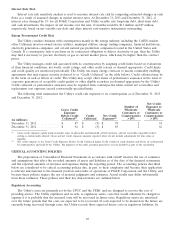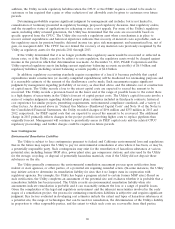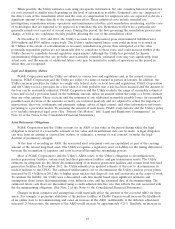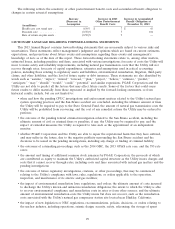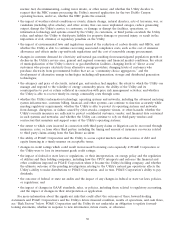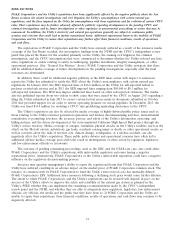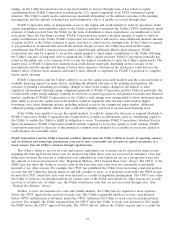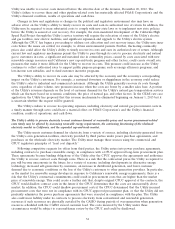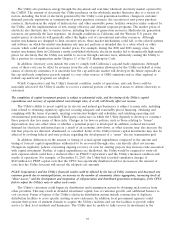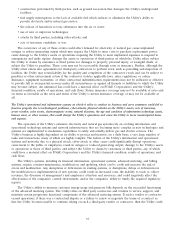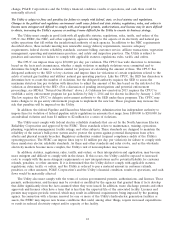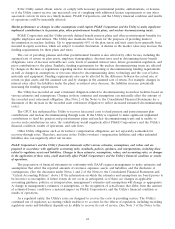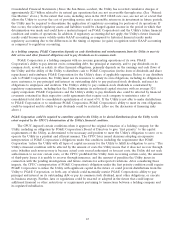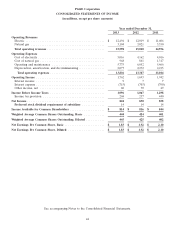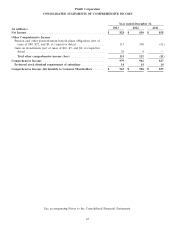PG&E 2013 Annual Report Download - page 41
Download and view the complete annual report
Please find page 41 of the 2013 PG&E annual report below. You can navigate through the pages in the report by either clicking on the pages listed below, or by using the keyword search tool below to find specific information within the annual report.The Utility also purchases energy through the day-ahead and real-time wholesale electricity market operated by
the CAISO. The amount of electricity the Utility purchases on the wholesale market fluctuates due to a variety of
factors, including, the level of electricity generated by the Utility’s own generation facilities, changes in customer
demand, periodic expirations or terminations of power purchase contracts, the execution of new power purchase
contracts, fluctuation in the output of hydroelectric and other renewable power facilities owned or under contract by
the Utility, and the implementation of new energy efficiency and demand response programs. The market prices of
electricity also fluctuate due to various factors, including the type of generation resources. Hydroelectric generation
resources are generally the least expensive. As drought conditions in California and the Western U.S. persist, the
market prices of electricity will generally reflect the higher cost of conventional and other resources. Although
market mechanisms are designed to limit excessive prices, these market mechanisms could fail, or the related systems
and software on which the market mechanisms rely may not perform as intended due to a cyber-attack or other
reason, which could result in excessive market prices. For example, during the 2000 and 2001 energy crisis, the
market mechanism flaws in California’s newly established wholesale electricity market led to dramatically high market
prices for electricity that the Utility was unable to recover through customer rates, ultimately causing the Utility to
file a petition for reorganization under Chapter 11 of the U.S. Bankruptcy Code.
In addition, electricity costs include the costs to comply with California’s cap-and-trade regulations. Although
some of these costs can be offset by revenues from the sale of emission allowances by the Utility on behalf of some
classes of electricity customers, it is uncertain how the cap-and-trade market will develop in the future especially as
the cap-and-trade compliance periods expand to cover other sources of GHG emissions and as other regional or
federal cap-and-trade programs are adopted.
PG&E Corporation’s and the Utility’s financial condition, results of operations, and cash flows could be
materially affected if the Utility is unable to recover a material portion of the costs it incurs to deliver electricity to
customers.
The completion of capital investment projects is subject to substantial risks, and the timing of the Utility’s capital
expenditures and recovery of capital-related costs through rates, if at all, will directly affect net income.
The Utility’s ability to invest capital in its electric and natural gas businesses is subject to many risks, including
risks related to obtaining regulatory approval, securing adequate and reasonably priced financing, obtaining and
complying with the terms of permits, meeting construction budgets and schedules, and satisfying operating and
environmental performance standards. Third-party contractors on which the Utility depends to develop or construct
these projects also face many of these risks. Changes in tax laws or policies, such as those relating to ‘‘bonus’’
depreciation, may also affect when or whether a potential project is developed. In addition, reduced forecasted
demand for electricity and natural gas as a result of an economic slow-down, or other reasons, may also increase the
risk that projects are deferred, abandoned, or cancelled. Some of the Utility’s future capital investments may also be
affected by evolving federal and state policies regarding the development of a ‘‘smart’’ electric transmission grid.
In addition, differences in the amount or timing of actual capital expenditures compared to the amount and
timing of forecast capital expenditures authorized to be recovered through rates, can directly affect net income.
Changes in regulatory policies concerning ongoing recovery of costs for existing projects may increase risks associated
with capital investment. Further, if capital expenditures are disallowed, the Utility would be required to write-off
such expenses which could have a material effect on PG&E Corporation’s and the Utility’s financial condition and
results of operations. For example, at December 31, 2013, the Utility had recorded cumulative charges of
$549 million for PSEP capital costs that the CPUC has specifically disallowed and for increases in the amount of
costs that the Utility forecasts will exceed the adopted cost amounts.
PG&E Corporation’s and the Utility’s financial results could be affected by the loss of Utility customers and decreased new
customer growth due to municipalization, an increase in the number of community choice aggregators, increasing levels of
‘‘direct access,’’ and the development and integration of self-generation and distributed generation technologies, if the CPUC
fails to adjust the Utility’s rates to reflect such events.
The Utility’s customers could bypass its distribution and transmission system by obtaining such services from
other providers. This may result in stranded investment capital, loss of customer growth, and additional barriers to
cost recovery. Forms of bypass of the Utility’s electricity distribution system include construction of duplicate
distribution facilities to serve specific existing or new customers. In addition, local government agencies could
exercise their power of eminent domain to acquire the Utility’s facilities and use the facilities to provide utility
service to their local residents and businesses. The Utility may be unable to fully recover its investment in the
35


